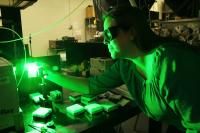Chemists develop new approach to inserting single carbon atoms
Skeletal editing employed to enlarge molecule rings
Molecules with a central ring system play an important role in the search for active ingredients for new pharmaceutical products – and it is important that the rings should have the correct size if the desired product is to be manufactured as efficiently as possible. For this purpose, an international team of chemists led by Prof. Frank Glorius (University of Münster) and Prof. Osvaldo Gutierrez (Texas A&M University, USA) have developed a precise and efficient tool using “single atom skeletal editing”. Their new approach consists in inserting a single carbon atom into the carbon skeleton of cyclic compounds, enabling the ring size to be adjusted from five to six-membered rings. The team has now published the method in the journal “Nature Catalysis”.
The results of the study, say the researchers, open up the way for the design and modification of complex molecular structures. Not only research but also industrial applications in pharmaceutical syntheses and in materials science could all benefit from the results.
Skeletal editing is a method used by chemists to replace atoms within a ring system. “In earlier approaches,” says Dr. Fu-Peng Wu from the University of Münster, “the focus was on the insertion of nitrogen atoms. By contrast, inserting a single carbon atom into an all-carbon ring is an enormous challenge. The carbon reagent needs to be compatible with various functional groups which determine the chemical properties of the molecule. In addition, the compound should be stable, easy to handle and susceptible to uncomplicated activation.” In recent decades, only a small number of such reagents have been developed.
The group led by Frank Glorius employed so-called photoredox catalysis, using light energy to drive the reaction. Using special reactive carbon fragments (radical carbynes), the researchers inserted single carbon atoms with various functional groups into indene. Indene is a starting material frequently used in the production of organic compounds, as is the product naphthalene.
Osvaldo Gutierrez and his group carried out mechanistic computations in order to detect the underlying reaction mechanism in the radical chain. As postdoc Dr. Remy Lalisse says, “Our calculations seem to suggest that the reaction takes place via an initial addition of a diazomethyl radical to indene.”
Original publication
Most read news
Original publication
Fu-Peng Wu, Chetan C. Chintawar, Remy Lalisse, Poulami Mukherjee, Subhabrata Dutta, Jasper Tyler, Constantin G. Daniliuc, Osvaldo Gutierrez, Frank Glorius; "Ring expansion of indene by photoredox-enabled functionalized carbon-atom insertion"; Nature Catalysis, 2024-1-9
Topics
Organizations
Other news from the department science

Get the chemical industry in your inbox
By submitting this form you agree that LUMITOS AG will send you the newsletter(s) selected above by email. Your data will not be passed on to third parties. Your data will be stored and processed in accordance with our data protection regulations. LUMITOS may contact you by email for the purpose of advertising or market and opinion surveys. You can revoke your consent at any time without giving reasons to LUMITOS AG, Ernst-Augustin-Str. 2, 12489 Berlin, Germany or by e-mail at revoke@lumitos.com with effect for the future. In addition, each email contains a link to unsubscribe from the corresponding newsletter.





























































